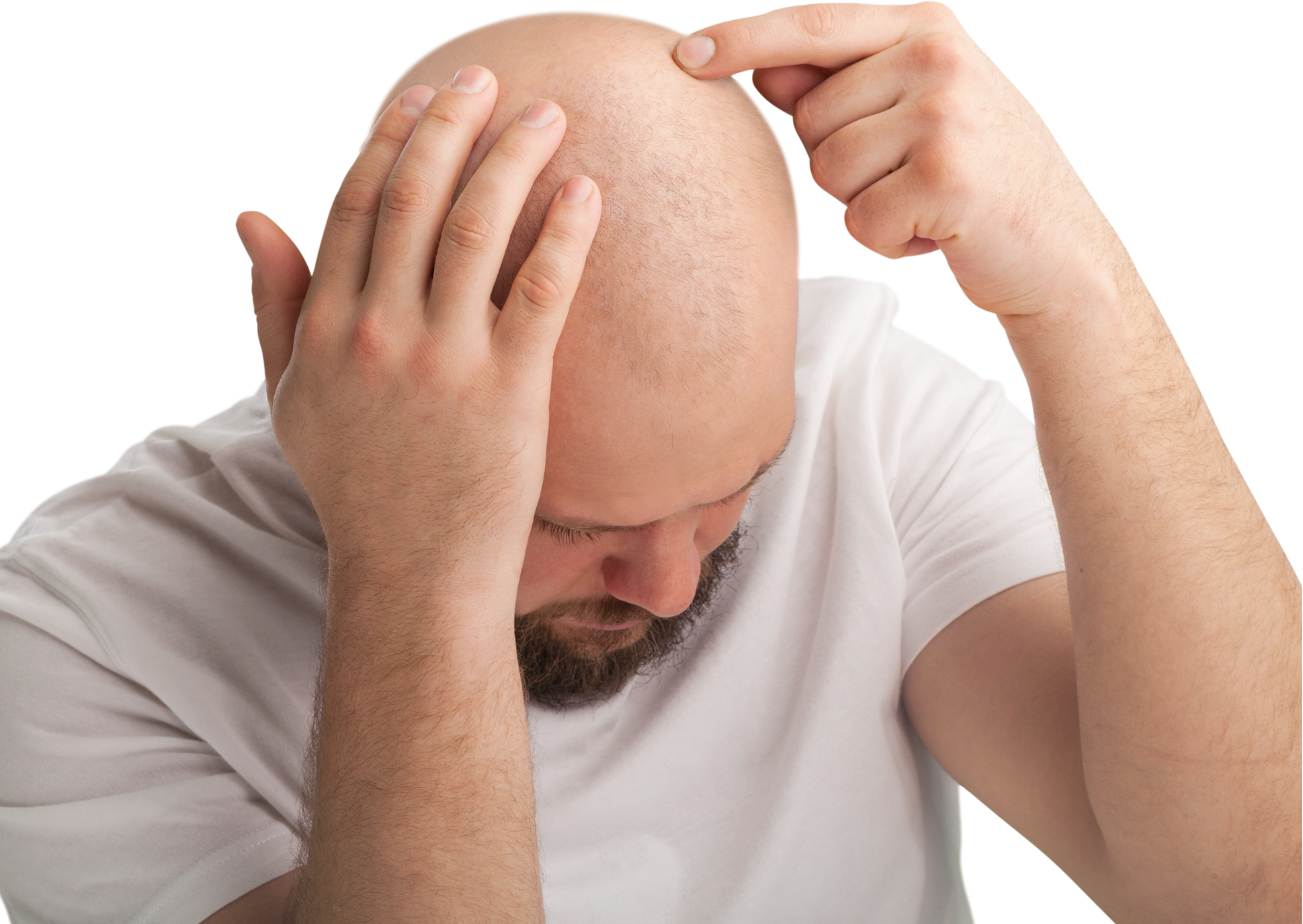Baldness is a medical condition in which an individual’s hair thins and becomes more susceptible to breakage. Baldness is typically accompanied by the loss of eyebrows, eyelashes, and body hair.
Table of Contents
There are several types of baldness:
Alopecia Barbae (also known as “Facial” or “Beard” hair loss) – the most common type of baldness, affects over 10 million men.
Alopecia Areata (also known as “spot baldness”) – common, brings on sudden hair loss which regrows after a few months (may repeat), usually does not recur after 5 years.
Congenital Alopecia – fertility issues, sparse hair in childhood.Traction alopecia (hair loss due to brushing or tight braiding, commonly experienced by African American women)
Trichotillomania (a strong urge to pull out one’s own hair which leads to noticeable bald patches)
Lichen Planus- a condition that causes a person’s immune system to attack normal cells, leading to hair loss on the entire body.
Hereditary- a genetic predisposition more likely if parents are bald or have gone through noticeable hair loss at an early age.Other conditions which may lead to Hair Loss: hormonal imbalance, thyroid disorders, skin infections, stress, diet, overuse of hair styling tools.
causes of baldness

It is important to note that men are more likely experiencing baldness at a younger age than women. The most common cause for excessive hair loss in men is Hereditary Male Pattern Baldness (male-pattern baldness). Hair follicles become smaller and shorter as one ages, making hair finer, sparser and less dense. Over time, the hair thins out. Male-pattern baldness is seen as a receding of the front hairline resulting in either a U-shaped or horseshoe shape on temples , crown area will begin to thin first.
Females typically don’t see visible signs of hair loss until they are past the age of 30, when menopause begins.
Excessive exposure to Dihydrotestosterone (DHT), a by-product of testosterone hormone which causes follicles to shrink . Genetics play key role in male pattern baldness. Baldness may also be caused by an underlying condition such as skin conditions, an autoimmune disorder or a thyroid condition.
Treatments/prevention
1.Minoxidil – This drug must be applied to the scalp twice daily to stop further hair loss in addition to stimulating new growth in some patients. It is not effective unless the balding process has been initiated and will only prevent further loss. This topical drug should only be used after other treatments have failed.
2) Finasteride (Propecia)- this pill is taken daily to inhibit the enzyme 5-alpha reductase, which converts testosterone into DHT in the body by blocking the absorption of nutrition essential for hair growth. It may take up to 6 months before any results appear. Only one pill is needed and it must be taken every day in order for the drug to work effectively. If this medication is discontinued, all hair growth will stop after 6-18 months (and most likely revert back to its original state).
3) Hair Transplant surgery – Surgery involves removing small round plugs of healthy hair-bearing skin to move to areas of hair loss. This method is the only one which yields permanent results, but also has a fairly high cost.
4) Protein Supplements – Protein supplements are not drugs by themselves, but they may help alleviate hair loss caused by nutritional deficiencies. Most notably L-Lysine and Zinc supplements have shown promising results.
5) Shampoos with Ketoconazole – This anti-fungal agent has been shown to block testosterone from being converted into DHT, one of the major causes for hair loss in both men and women.
6) Scalp Micropigmentation (SMP/SMA)- This cosmetic method is a tattoo that gives the illusion of hair follicles. Many people go for this treatment because it is non-invasive and is long lasting.
7) Hair Loss Concealers – These can be used as a temporary fix until one decides to undergo surgery or find something more permanent such as SMP/SMA, which cover bald patches with tiny fake hair strands. Just apply like regular hair gel and comb into place.
8) Hair Loss Shampoo – These shampoos are basically an addition to other products. They’re designed specifically for people with receding hairlines, but they’re not considered a cure-all by any means. The shampoo should be used in conjunction with other treatments.
There are also things that can be done to help prevent hair loss. Washing the hair with cool water will allow natural oils to remain in the hair shaft, reducing dryness and breakage. Excessive heat from blow-dryers, curling irons etc should be avoided as it can severely damage the hair cuticle, causing hair to lose its elasticity.
The use of chemical relaxers or permanents should be avoided since the chemicals in these treatments break down the protein structure of hair, making it brittle and more likely to fall out. Other things that one can do include limiting repetition when styling the hair, avoiding too many hot showers/baths, not wearing tight-fitting hats or ponytails, and avoiding exposure to harsh chemicals such as chlorine.
Male pattern baldness
Male pattern baldness is also called androgenetic alopecia because it is caused by hormones known as androgens. Androgens are a group of hormones that bring about sexual differentiation in human development. It regulates the growth and function of male reproductive tissues, but it also plays a part in other parts of the body including the skin, hair follicles and bones. In hair loss sufferers , this causes hair follicles to become sensitive to normal levels of androgen.
This means that they produce more hair than they can sustain, which results in the death of the follicle and thus death of the hair . The more active the testosterone, DHT or Androstanediol glucuronide are in these areas, the greater number of sensitive follicles are present. When this happens , it causes the thinning of the scalp as well as an increase in the size of the forehead. In severe cases , this may result to complete baldness
Heredity and sex
The role of heredity cannot be ignored when talking about male pattern baldness . This is because a majority of those who have this kind of hair loss also have a family history of it. In some instances, a father’s genes can pass on to the son while his mother passes on her genes to the daughter .
Studies have shown that if one parent has male pattern baldness, there is a 50% chance for each child to inherit it. In other words , if both parents are affected with this hair type, there is a 50% chance for sons to inherit it while daughters have a 50% chance of inheriting it.
This percentage increases with age. For instance , if only one parent has this hair type , the child’s chances go up to 65% . Of course, this time , it applies to only the males because only 1% of women develop this kind of hair loss.
Baldness and the scalp
Hair follicles affected by male pattern baldness do not produce as much natural oil known as sebum, which is responsible for keeping the scalp moisturized and healthy. This causes dandruff and itching. It also makes the scalp more susceptible to certain problems. Male pattern baldness will lead to the thinning of hair, especially at the crown and the front of the scalp . The condition may also cause receding hairlines or bigger foreheads.
Experts believe that male pattern baldness has something to do with testosterone . It is said that men who are genetically predisposed to male pattern baldness will start to lose their hair once they reach 50 years old.
According to the American Hair Loss Association, 2/3 of men will experience this kind of hair loss by the time they reach 60 . The good news is that there are treatments available for those who wish not to go full-blown bald . One such treatment is Propecia.
This FDA-approved pill is known to slow down or stop hair loss in men . It has been reported that Propecia works best on the crown area and the top of the head where male pattern baldness starts . More importantly, it does not cause sexual side effects like its competitor finasteride.
Female pattern hair loss
Female pattern hair loss is also called female alopecia or baldness . It occurs when a hormone known as dihydrotestosterone (DHT) affects the growth of scalp hair. In this condition, DHT constricts the hair roots, which eventually prevents new hairs from growing back once they fall out.
The hormone estrogen inhibits the production of DHT in the body, which is why it may seem that woman are not as much affected by male pattern baldness . However , when these levels drop for some reason , DHT becomes more active in the scalp. This eventually leads to thinning or complete hair loss in certain areas of the head.
what is genetic hair loss?
Hair loss is a very common problem. In fact, it affects more than 50 million people in the United States and probably many more worldwide!
The most common type of hair loss is called “androgenetic alopecia,” or commonly known as male pattern baldness in men or female pattern baldness in women. This condition is characterized by the progressive miniaturization of scalp hair, resulting in thinning.
The main cause of this type of hair loss is genetic predisposition or family history – basically, if your mother or father had/has this condition then you are more likely to be affected as well.
While there isn’t yet a cure for Alopecia, there are a variety of treatments that have been shown to be effective in slowing down the condition’s effects. These include medications such as topical minoxidil and finasteride. In addition, hair transplant surgery has become a common procedure for restoring hair in individuals with Androgenetic Alopecia.
Is hair inherited from mother or father?
Hair is inherited from both parents. Each parent would pass a certain kind of hair to the offspring.
Is it more likely for a girl or boy to go bald?
In most cases, males will develop some form of pattern baldness at some point in life while women may experience thinning hair but baldness is less common among women.
Is there a difference between the kinds of hair that boys and girls get?
Yes, males tend to see receding hairlines and more loss on top while females tend to experience thinning at the sides and crown.
How long does it take for hair to grow?
It takes about 3-4 years for a hair to grow from the root and push its way out through the skin.
How much does each strand of hair weigh?
Each strand of your hair is about 100 micrometers wide and has a diameter of 40-50 micrometers. A strand weighs roughly 50 micrograms, which is just under half the weight of one grain of rice.
Can you lose the same amount of hair everyday as you do grow it?
This is difficult to answer as we naturally shed about 50-100 hairs a day and we usually don’t notice this loss because new ones replace them.
what is hereditary hair loss?
Hereditary hair loss is when a person’s hair begins thinning or even starts to completely disappear.signs of hereditary loss can be noticed in many ways. Some symptoms are permanent, while others are temporary, making it impossible for the individual to tell if their condition will last until the end of their life.
How does baldness gene work?
The gene that is associated with baldness, called the Androgen Receptor Gene, comes in two different forms. One form of this gene leads to the development of male pattern baldness , where hair becomes thinner and eventually disappears. The other form does not have any effect on the individual’s appearance or personality.







